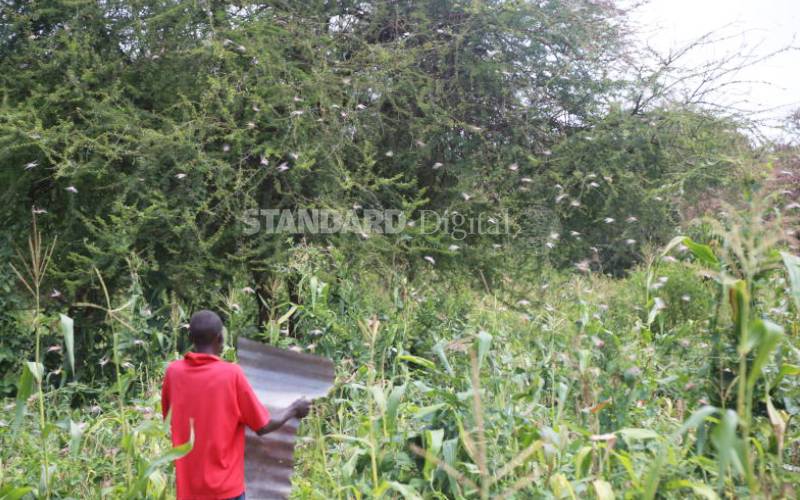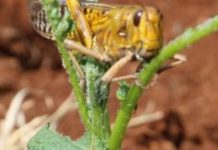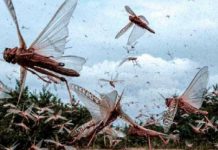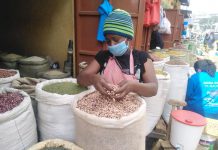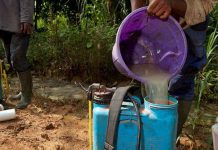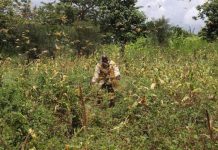Armed with a sizable piece of iron sheet and a stick, Julius Maluki moves from one corner of his farm to another hitting a plate incessantly and producing ear-piercing noise that can be heard from across his farm.
The farmer, who has grown maize and cow peas, shouts himself hoarse while stomping his feet hard on the ground.As he does this, a small swarm of desert locusts, part of thousands upon thousands that invaded his farm at Enziu village and several other parts of Mwingi region fly just above his head and perch in nearby trees. The bulk of the insects is unmoved.Maluki hopes the noise, coupled with his other gymnastics, will scare the ravenous insects away. However, from all indications, his efforts are a desperate exercise in futility.
“We have resorted to using rudimentary methods to chase the locusts away, but they have proven stubborn. I can only watch as they consume my crops away,” says Maluki, his face showing clear signs of giving up.That was last week. Today, Maluki says the insects have rendered him destitute, having decimated the cowpeas and green grams on his three-acre farm.Maluki had expected to harvest at least 20 90-kilogramme bags of cow peas, but the unwelcome visitors have left him counting losses.
Esther Kyalo, a farmer from the neighbouring Nguni area, is in a similar predicament. Her lush crop of green grams was reduced to ugly strands as the locusts devoured all the leaves.“I was looking forward to a bumper harvest of 15 90-kilogramme bags of green grams but now there is nothing left. Does it mean the government has no capacity to contain this menace?” she asked.
A kilogramme of green grams goes for between Sh50 and Sh70 in local markets.In Mutwangombe, within the same neighbourhood, Theophilus Kimanzi, who grows millet and green grams, is also counting losses. The locusts descended on his farm and in two days, decimated every strand of millet and green grams.“I depend on farming for my livelihood. I even borrowed money to buy those seeds.
Now I don’t know what to do because all the crop has been destroyed,” Kimanzi lamented.“We are tired of screaming and hollering in farms to make noise. The three aerial spraying conducted so far have had zero results. We want the government to come up with a better and more effective measure to kill the locusts,” he added.
The first swarm was spotted a week ago at Kyuso, Ngomeni and Tseikuru in Mwingi North, where the insects were reported to have entered Kitui County through Kora National Park, which extends from Mwingi North to Meru National Park.
What looked like a quick intervention was mobilised with aerial spraying being undertaken for two days to contain the locusts. Curiously, farmers say the pests did not die despite assurances that they would die a slow death within 72 hours.According to farmers, the pests have become bolder, fiercer and more organised in their invasion and terror. Within one week, they terrorised farmers in many other parts of Mwingi region, including Nguni, Enziu, Waita, Kivou, Mathyakani, Mbondoni, and Kiomo-Kyethani.
The highlight of this ugly spectacle was last Sunday evening when a cloud of locusts kicked off their flight from Waita, and in their millions overflew Mwingi town and in record time pitched camp in Migwani market – some 35km away – much to the chagrin of local farmers.
The following morning, they descended on farms within Kyamboo and Thokoa villages pulverising the farms and scaring school-going children.“The aerial spraying did not work. They are not dying and the government should come up with a more effective drug. The damage on crops is unimaginable,” said Martha Ngumbau from Mathiakani area of Mwingi Central.
The farmers now want the government to compensate them for their losses.The United Nation’s Food and Agriculture Organisation (FAO) has made a preliminary appeal of Sh7 billion ($70 million) to facilitate the fights against desert locusts that have ravaged 13 counties.Assistant FAO representative to Kenya Hamisi Williams said the organisation was in Rome on Thursday last week to appeal to the donors for funds.
“FAO has also mobilised over $2 million (Sh200 million) of its own resources to the situation in Kenya,” said Mr Hamisi.The funds are expected to add to the Sh400 million that FAO said had been provided by the UN’s CERF (Central Emergency Response Fund) fund on January 22.“More reliable figures on this will be available in the coming days. Already some 3.1 million people in Kenya are projected to be highly food insecure between August and October 2019,” said Hamisi.
While FAO has made public its expenses in the fight against the swarms of destruction, the Ministry of Agriculture says it is unable to give an accurate figure on the expenses.It was only on January 14 that Agriculture Cabinet Secretary Peter Munya said the Government had injected Sh230 million to support the fight against the swarms, which by then had affected eight counties. He did not disclose how much had been used in the past.The ministry also said it was unable to quantify the losses incurred by the farmers in the affected counties.
The Principal Secretary State Department for Crop Development and Agricultural Research, Hamadi Boga, said it was difficult to estimate the cost of combating the locusts since there were other organisations, including FAO, county governments, desert locust control organisation and Intergovernmental Authority on Development (Igad) that were using their own resources.However, he said that 20,000 litres of chemicals had so far been used in the fight.“The ministry will not do the estimation of the losses; there will be another agency to do that. At the moment, we are concerned with locating the swarms and spraying them,” he said.
Hamadi said despite the challenges that also include high cost of purchasing pesticides, the fight against the destructive swarms would continue to prevent further losses that may lead to food insecurity in the country.
The PS noted that the desert locusts were likely to continue causing havoc in the country unless the weather changed.Hamadi said many challenges were watering down efforts to contain the locusts. The expected changes include the blow of wind to drive the swarms out of the country and end of persistent rains that grant the locusts a fertile ground for breeding.
The PS blamed laxity in Somalia, where locusts were coming from, and unreliability of the ongoing aerial spraying. The country has since declared the invasion an emergency.Hamadi said aerial spraying that was currently being used was faced with many challenges that limited its efficiency.
“The effectiveness of the spraying depends on how it is executed. Many things can go wrong. You must know the direction the wind is blowing and the height the plane flies also affects the spraying. If the pilot is afraid of flying low enough, then it is bound to miss the target,” said Hamadi.Questions have also arisen on safety of the chemicals being used in spraying the pests.
The National Climate Change Secretariat and the East Africa Climate Change Network (EACCNET) had advocated alternative method of fighting the swarms over fear of environmental hazards.“The pesticides are safe just like other pesticides use in agriculture,” PS Hamadi said as he dismissed claims that the pesticides were posing health risks to people and animals.

